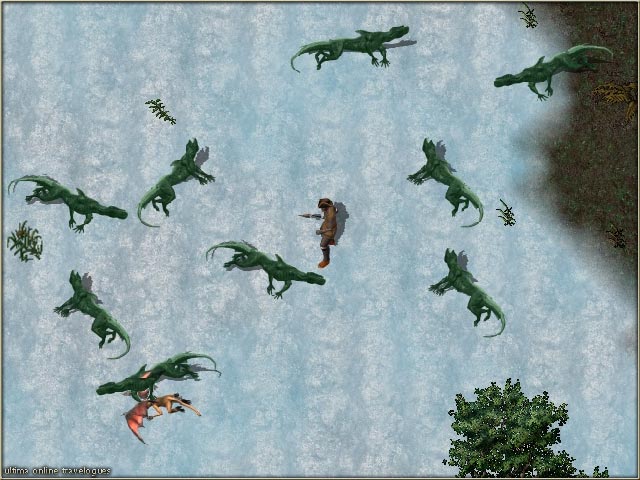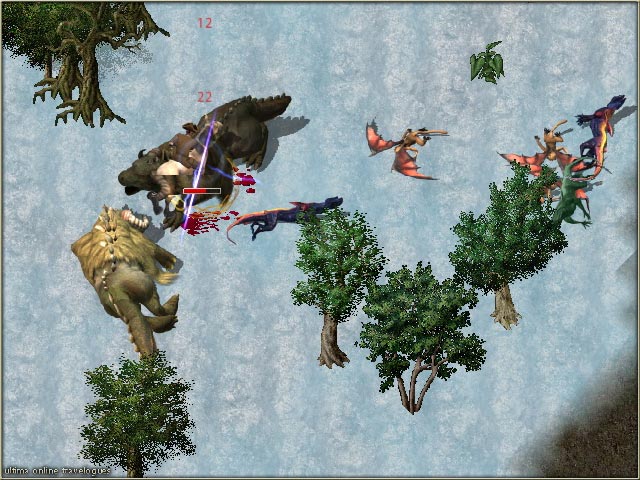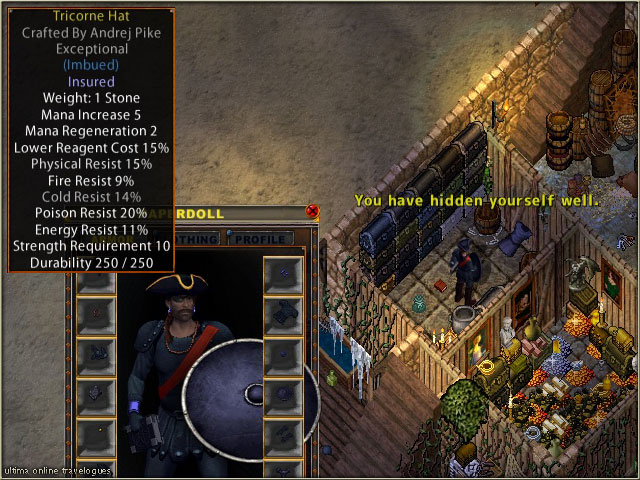Sambal Dragor, Legendary Artificer
 mbuing was a new skill that was discovered after the opening of the new land Ter Mur. The skill was quite useful, as it allowed the crafter to add specific magic abilities to armor, weapons and jewelry. Crafters no longer needed to waste their time with mindless repetitive tasks in order to acquire a runic tool which would only yield random results. No, they now could add specific magic properties to basic items. Sambal Dragor figured that this would prove most useful for rings, bracelets and pirate hats. Especially the latter hadn't been available in good quality until now. Thus he decided to learn the skill.
mbuing was a new skill that was discovered after the opening of the new land Ter Mur. The skill was quite useful, as it allowed the crafter to add specific magic abilities to armor, weapons and jewelry. Crafters no longer needed to waste their time with mindless repetitive tasks in order to acquire a runic tool which would only yield random results. No, they now could add specific magic properties to basic items. Sambal Dragor figured that this would prove most useful for rings, bracelets and pirate hats. Especially the latter hadn't been available in good quality until now. Thus he decided to learn the skill.
After imbuing literally thousands of daggers by the soulforge in the newly discovered gargoyle land Ter Mur in order to improve his skill, Sambal Dragor finally found a place in Britannia where he could continue learning the arts of Imbuing. The large house was located in the village of Aegis, somewhere in the woods of Yew. The building contained a crafted soulforge, which - contrary to the soulforges in the Royal City - decreased the success chance of imbuing, but was appropriate for studying the skill for that same reason.
It quickly dawned on Sambal Dragor that he would need lots of Magical Residue to train the Imbuing skill. In the process of becoming a Legendary Artificer, Sambal burned approximately 40,000 Residue. He acquired those by hunting monsters and unraveling their loot. The gold he earned from monster hunting was used to buy the gems which were also required for Imbuing.

Sambal soon realized how useful this skill was. When his skill reached 80, he was already able to create useful equipment, like a suit with 100% Lower Reagent Cost or skill-increasing jewelry.
After many weeks of studying, Sambal Dragor finally was Legendary Artificer. For his imbuing work, he would now use the soulforges in the Royal City, as they would give a bonus to his success chance. The highest bonus (+5%) was granted by the Queen's Soulforge inside the palace of the Royal City. However, to be allowed to use it, the Artificer must have earned the Queen's loyalty by slaying monsters in Ter Mur. So Sambal headed east, crossed a bridge over some river and reached an area that was home to Sliths, Bouras, Mongbats and an occasional Silver Serpent. He soon figured out that slaying Toxic Sliths would increase his loyalty rating most efficiently. Being a skilled lumberjack, Sambal knew how to swing an axe and killed about 300 Sliths. He had gathered about 50 slith tongues from these creatures, which was also an imbuing ingredient needed to add "Hit Dispel" to weapons.

Sambal also hunted Lowland Bouras and Ruddy Bouras who lived here, as some of them carried boura pelts, which were required to increase the resist values of armor and hats to a high level. He would need those to make a nice tricorne for his companion, the pirate Sharkeye Pike.

Andrej Pike the tailor sew dozens of tricornes before he finally made one he was satisfied with. First, the item had to be made more durable by using Powder of Fortifying. For after an item was imbued, Powder of Fortifying cannot be used on it anymore, ever. Unfortunately, the price of the powder had tripled after Imbuing had become popular.
It is also important to know that if you imbue a resist value on an armor piece, the new value will replace the original value the item. Thus, those resists you want to imbue on the hat should be as low as possible on the original piece, in order to waste as few total resists as possible. In this case, Physical Resist and Poison Resist were to be imbued on the tricorne, to match Sharkeye's suit. Sambal raised these to the maximum (15 Physical and 20 Poison Resist), for which he consumed 20 boura pelts.
As Sharkeye Pike was a mage, Sambal also wanted to imbue Lower Reagent Cost and Mana Regeneration on the hat. For Lower Reagent Cost he would need only regular gems, but for Lower Mana Cost, 10 of the rare ingredient called "seed of renewal" were required. Fortunately, Andrej Pike had collected some of those by his recent plant growing project. As the gems, residue and essence (as well as relic fragments) will be lost upon failing, Sambal first imbued the most costly property to the maximum. After adding all necessary properties to the hat, it still had room for some magic abilities, so Sambal added Mana Increase 5. This had become a fine tricorne indeed!

01/2010
 Previous story Previous story |
 Next story Next story |
How to Train the Imbuing Skill
[ Imbuing ingredients, their use, and where to find them ]
Imbuing training will require hundreds of thousands of gems (especially amber and citrine), which you can buy at any jeweler's store in town for 50gp a piece. It is recommended to compare prices, as they vary quite a bit. If someone bought the vendor empty a couple of times before you arrived, the price will be higher. So, the gem problem can be solved by throwing gold at it. However, the many residues you need cannot be bought. I found that the most efficient way to gather them, is to slay creatures who carry lots of magic items as loot. Gather as many magic items as you can carry in an empty bag and bring it back to your house for your Artificer to unravel. Unraveling these items will yield residue. The higher the Imbuing skill, the more residue you will get. After 5 runs, you will have enough residue for a while, and more gold than you need to buy gems. Repeat if you run out of residue.
When training Imbuing, you should always try to find a way to use as few residue as possible. To help you with that, I wrote down a very efficient way to achieve that goal, but without torturing you with too many mouse clicks.
When training Imbuing, always select an intensity where the success chance is below 61%. Above 60% you can still get gains, but they slow down noticably, especially when your Imbuing skill has risen above 70. The success chance depends on the magic properties the item already has, the race of your character, his skill, and the soulforge you use. It is recommended to train with a non-gargoyle on a crafted soulforge (as the bonuses of a gargoyle and the soulforges in the Royal City will be contraproductive for skill training). You can still transfer the skill over to a gargoyle with a soulstone, once you're done training.
The easiest way to reach 50 skill is to create a new character with Imbuing as a starting skill. Use a soulstone to transfer the skill over to your crafter.
From 50-75 skill, craft many exceptional daggers with GM Arms Lore. Imbue them once, then unravel them (as Residues are harder to get than daggers to craft). By unraveling them, you often will get your Residue back. Imbue Hit Dispel with the appropriate intensity to the dagger.
Above 75, start imbuing Reflect Physical Damage to exceptional samurai plate jingasas (as they automatically have the Mage Armor property, thus saving you residue for imbuing higher magic weight to the item). Imbue them 20 times before unraveling, as they are more costly to make than Residues are to get. Imbue Reflect Physical Damage with the appropriate intensity to the armor pieces, to keep the success chance on the required level.
Around 81, you will have to start imbuing 10% Reflect Physical Damage to the Jingasas, which cost you 2 residue per imbue.
Around 88 skill, double imbues begin. Imbue Reflect Physical Damage once and then Lower Reagent Cost 19 times to the item. The first imbue will lower the success chance for the second to twentieth, thus saving you lots of resources. You start out with 5% Reflect Physical and 5% LRC. Raise Reflect Physical if neccessary, so you can keep the cost for imbuing LRC 19 times at a minimum. For the second to twentieth imbue always make sure that you keep the success chance below 61% and the consumation of Residue as low as possible.
At 101 skill you can start with triple imbues. First imbue 11% Reflect Physical Damage, then 3% Lower Reagent Cost, then 18 times Luck. Raise RPD (not higher than 13%) and LRC in the process to keep the 18 following Luck imbues at a minimum cost of 1 Residue and 1 Citrine (you can do that up to 19 Luck). Again, make sure your success chance does not raise above 61%.
For example, when you reach 115 skill, you will imbue on each Plate Jingasa:
- 01x 13% Reflect Physical Damage (4 Residue, 8 Citrine)
- 01x 13% Lower Reagent Cost (3 Residue, 6 Amber)
- 18x 16% Luck (1 Residue, 1 Citrine) (success chance: 59,8%)
At 117 skill, you will imbue:
- 01x 13% Reflect Physical Damage (4 Residue, 8 Citrine)
- 01x 15% Lower Reagent Cost (3 Residue, 7 Amber)
- 18x 11% Luck (1 Residue, 1 Citrine) (success chance: 60,1%)
 Previous story Previous story |
[ Back to the overview ] |  Next story Next story |



